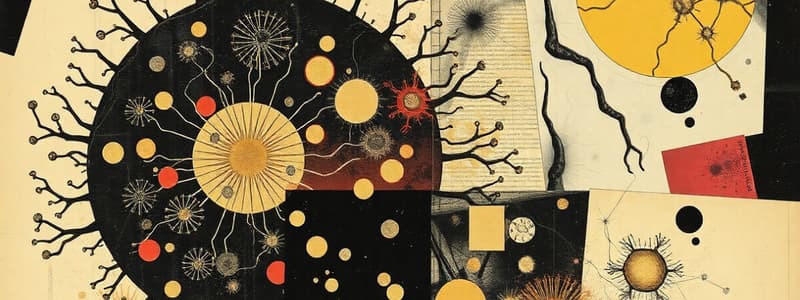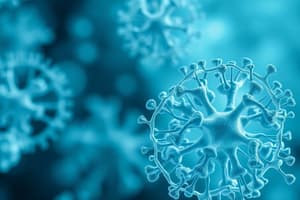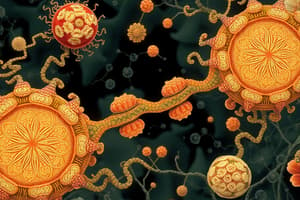Podcast
Questions and Answers
Which of the following best describes metabolism?
Which of the following best describes metabolism?
- The breakdown of larger molecules into smaller molecules.
- The process that forms larger macromolecules from smaller molecules.
- The synthesis of complex molecules.
- All chemical and physical workings of a cell. (correct)
What is the primary role of catabolism in microbial metabolism?
What is the primary role of catabolism in microbial metabolism?
- To degrade larger molecules into smaller ones, releasing energy. (correct)
- To form larger macromolecules.
- To synthesize macromolecules.
- To create energy input.
Which of the following statements accurately describes anabolism?
Which of the following statements accurately describes anabolism?
- It requires energy input to synthesize macromolecules. (correct)
- It is a degradative process.
- It releases energy by breaking down larger molecules.
- It forms smaller molecules.
Which type of work involves the synthesis of complex molecules within a cell?
Which type of work involves the synthesis of complex molecules within a cell?
According to the first law of thermodynamics, what happens to energy in the universe?
According to the first law of thermodynamics, what happens to energy in the universe?
What is the term for the amount of 'disorder' in a system?
What is the term for the amount of 'disorder' in a system?
What typically happens to entropy in the universe over time?
What typically happens to entropy in the universe over time?
Which of the following is NOT a role of ATP in metabolism?
Which of the following is NOT a role of ATP in metabolism?
What type of reaction is coupled with the exergonic breakdown of ATP to drive metabolic processes?
What type of reaction is coupled with the exergonic breakdown of ATP to drive metabolic processes?
Which characteristic is unique to enzymes?
Which characteristic is unique to enzymes?
What term describes an enzyme composed of both protein and nonprotein components?
What term describes an enzyme composed of both protein and nonprotein components?
What is the function of the enzyme's active site?
What is the function of the enzyme's active site?
How do enzymes increase the speed of a chemical reaction?
How do enzymes increase the speed of a chemical reaction?
Which model describes how an enzyme adjusts its shape to fit the substrate better?
Which model describes how an enzyme adjusts its shape to fit the substrate better?
An enzyme that catalyzes the transfer of chemical groups between molecules is classified as a:
An enzyme that catalyzes the transfer of chemical groups between molecules is classified as a:
What is the function of hydrolase enzymes?
What is the function of hydrolase enzymes?
Which type of enzyme is responsible for breaking C-C, C-O, and C-N bonds by means other than hydrolysis?
Which type of enzyme is responsible for breaking C-C, C-O, and C-N bonds by means other than hydrolysis?
An enzyme that catalyzes the conversion of L-alanine to D-alanine is classified as:
An enzyme that catalyzes the conversion of L-alanine to D-alanine is classified as:
Which of the following best describes the function of ligase enzymes?
Which of the following best describes the function of ligase enzymes?
What metabolic process is regulated via 'post-translational modification'?
What metabolic process is regulated via 'post-translational modification'?
In competitive inhibition, what directly competes with the substrate?
In competitive inhibition, what directly competes with the substrate?
What regulatory site is involved in allosteric inhibition?
What regulatory site is involved in allosteric inhibition?
What is the primary action of a noncompetitive inhibitor?
What is the primary action of a noncompetitive inhibitor?
What is the fundamental principle behind oxidation-reduction (redox) reactions in metabolism?
What is the fundamental principle behind oxidation-reduction (redox) reactions in metabolism?
Why are electron carriers essential in metabolic processes?
Why are electron carriers essential in metabolic processes?
What is the correlation of elections to energy?
What is the correlation of elections to energy?
In general, the greater the difference between the reduction potential (Eo) of the donor and acceptor in a redox reaction, the:
In general, the greater the difference between the reduction potential (Eo) of the donor and acceptor in a redox reaction, the:
What molecules are coenzymes?
What molecules are coenzymes?
Which of the following is NOT a mechanism of ATP synthesis?
Which of the following is NOT a mechanism of ATP synthesis?
What is substrate-level phosphorylation?
What is substrate-level phosphorylation?
Correctly label each of the stages of primary catabolism:(1, 2, 3)
Correctly label each of the stages of primary catabolism:(1, 2, 3)
What is the end product of glycolysis under aerobic conditions (when oxygen is present)?
What is the end product of glycolysis under aerobic conditions (when oxygen is present)?
What is the primary function of the electron transport system (ETS)?
What is the primary function of the electron transport system (ETS)?
What is the role of oxygen in aerobic respiration?
What is the role of oxygen in aerobic respiration?
In anaerobic respiration, what serves as the terminal electron acceptor?
In anaerobic respiration, what serves as the terminal electron acceptor?
Which metabolic process uses organic compounds as terminal electron acceptors?
Which metabolic process uses organic compounds as terminal electron acceptors?
Which of the following best describes fermentation?
Which of the following best describes fermentation?
Which stage of aerobic respiration generates the most ATP?
Which stage of aerobic respiration generates the most ATP?
If a microorganism were metabolizing glucose via fermentation, which of the listed end-products is least likely to occur?
If a microorganism were metabolizing glucose via fermentation, which of the listed end-products is least likely to occur?
What is the theoretical maximum ATP yield in aerobic respiration?
What is the theoretical maximum ATP yield in aerobic respiration?
Which component is NOT a crucial element commonly found in organic molecules within a cell?
Which component is NOT a crucial element commonly found in organic molecules within a cell?
If a bacterium requires only simple inorganic compounds for growth, it is likely a(n):
If a bacterium requires only simple inorganic compounds for growth, it is likely a(n):
Which of the following statements accurately describes the function of energy in cells?
Which of the following statements accurately describes the function of energy in cells?
What is the ultimate fate of energy during energy transformation, according to the laws of thermodynamics?
What is the ultimate fate of energy during energy transformation, according to the laws of thermodynamics?
Which of the following is NOT a means by which enzymes lower activation energy?
Which of the following is NOT a means by which enzymes lower activation energy?
What is the crucial role of the metal ion within a metalloenzyme?
What is the crucial role of the metal ion within a metalloenzyme?
Which event would NOT typically occur during post-translational modification?
Which event would NOT typically occur during post-translational modification?
What is the key characteristic of 'uncompetitive inhibition' in enzymatic reactions?
What is the key characteristic of 'uncompetitive inhibition' in enzymatic reactions?
In a redox reaction, if a molecule gains electrons, which of the following occurs?
In a redox reaction, if a molecule gains electrons, which of the following occurs?
What is the role of the respiratory chain?
What is the role of the respiratory chain?
Which statement is the most accurate concerning anaerobic respiration compared to aerobic respiration?
Which statement is the most accurate concerning anaerobic respiration compared to aerobic respiration?
If a bacterium is capable of fermentation, what is a possible fate of pyruvic acid?
If a bacterium is capable of fermentation, what is a possible fate of pyruvic acid?
What is the primary reason why ATP production is substantially lower during fermentation compared to aerobic respiration?
What is the primary reason why ATP production is substantially lower during fermentation compared to aerobic respiration?
A mutant bacterium is unable to produce a functional ATP synthase. Which of the following is the MOST likely consequence?
A mutant bacterium is unable to produce a functional ATP synthase. Which of the following is the MOST likely consequence?
Identify the INCORRECT pairing.
Identify the INCORRECT pairing.
Flashcards
Metabolism
Metabolism
All the chemical and physical workings of a cell.
Catabolism
Catabolism
Breaks down larger molecules into smaller ones, releasing energy.
Anabolism
Anabolism
Biosynthesis; forms larger macromolecules from smaller molecules, requiring energy input.
Energy
Energy
Signup and view all the flashcards
Thermodynamics
Thermodynamics
Signup and view all the flashcards
First Law of Thermodynamics
First Law of Thermodynamics
Signup and view all the flashcards
Entropy
Entropy
Signup and view all the flashcards
ATP's Role in Metabolism
ATP's Role in Metabolism
Signup and view all the flashcards
Enzymes
Enzymes
Signup and view all the flashcards
Simple enzymes
Simple enzymes
Signup and view all the flashcards
Conjugated enzymes
Conjugated enzymes
Signup and view all the flashcards
Activation Energy
Activation Energy
Signup and view all the flashcards
Competitive inhibition
Competitive inhibition
Signup and view all the flashcards
Noncompetitive inhibition
Noncompetitive inhibition
Signup and view all the flashcards
Oxidation-Reduction Reactions
Oxidation-Reduction Reactions
Signup and view all the flashcards
Electron Transfer
Electron Transfer
Signup and view all the flashcards
Substrate-level phosphorylation
Substrate-level phosphorylation
Signup and view all the flashcards
Oxidative phosphorylation
Oxidative phosphorylation
Signup and view all the flashcards
Photophosphorylation
Photophosphorylation
Signup and view all the flashcards
Bioenergetics
Bioenergetics
Signup and view all the flashcards
Aerobic respiration
Aerobic respiration
Signup and view all the flashcards
Anaerobic respiration
Anaerobic respiration
Signup and view all the flashcards
Fermentation
Fermentation
Signup and view all the flashcards
Pyruvate products
Pyruvate products
Signup and view all the flashcards
Redox rxns
Redox rxns
Signup and view all the flashcards
Study Notes
- Chapter 8 covers introduction to microbial metabolism
Microbial Growth
- Microbial growth depends on available resources/energy and suitable environmental conditions
- Assessment includes mechanics of microbial growth
- Chemoheterotrophs like E. coli require a source of energy, carbon, hydrogen, oxygen, nitrogen, and phosphorus, with approximately 5000 compounds and 4000 proteins
Metabolism Overview
- Metabolism is the sum of all chemical and physical workings of a cell
- It involves two types of chemical reactions called catabolism and anabolism
Catabolism
- Catabolism involves degradative reactions
- Breaks down larger molecules into smaller molecules
- Releases energy in the process
Anabolism
- Anabolism involves biosynthesis reactions
- Forms larger macromolecules from smaller molecules
- Requires energy input
Life's Work and Energy
- Life necessitates work in the form of chemical synthesis, transport processes, and mechanical actions like cell motility
- Energy is defined as the capacity to do work
Thermodynamics
- Thermodynamics is fundamentally the study of energy transformations
Laws of Thermodynamics
- The First Law of Thermodynamics states energy can neither be created nor destroyed, only redistributed within or between systems
- The Second Law of Thermodynamics addresses entropy (disorder) in a system
- Physical and chemical processes proceed in a way that increases the disorder of the universe to the maximum extent possible
Cellular Bioenergetics and ATP
- ATP is a central molecule in cellular energetics
- Anabolic processes require ATP
- Catabolic processes release energy
- Exergonic reactions increase entropy, indicated by a negative change in Gibbs free energy (-ΔG)
Role of ATP in Metabolism
- ATP's exergonic breakdown is coupled with endergonic reactions to make them more thermodynamically favorable
- The hydrolysis of ATP to ADP + Pi releases energy: ATP + H2O → ADP + Pi + H+; ΔG°' = -7.3 kcal/mol
Metabolic Pathways and ATP
- Aerobic respiration, anaerobic respiration, and fermentation are metabolic pathways starting with glucose
- ATP is the "energy currency" which drives chemical, transport, and mechanical work via anabolism
Enzyme Structure and Classification
- Enzymes increase a reaction's rate without being permanently altered
- They have high specificity for the reaction they catalyze and the molecules they act on
- Substrates are reacting molecules, and products are the substances formed by the reaction
- Some enzymes consist solely of one or more polypeptides, while others are composed of polypeptides and nonprotein components
- The reaction scheme for this is E + S → ES → E + P, where E is enzyme, S is substrate, ES is enzyme-substrate complex, and P is product
Enzyme Types
- Simple enzymes consist of protein alone
- Conjugated enzymes (holoenzymes) contain protein and nonprotein molecules
- Apoenzyme is the protein portion of a conjugated enzyme
- Cofactors are the nonprotein portion, comprised of inorganic elements (metal ions) or organic molecules (coenzymes)
Enzyme Mechanisms
- Enzymes lower the activation energy (Ea), speeding up reactions
- Enzymes lower Ea by increasing substrate concentrations at the active site and orienting substrates to form transition-state complexes
- The induced fit model explains enzyme-substrate interaction
Enzyme Interactions
- Enzymes lower Ea by increasing substrate concentrations at the active site and orienting substrates to form transition-state complexes
- The induced fit model explains enzyme-substrate interaction
Redox Reactions
- Redox reactions are fundamental in metabolism because they involve oxidation-reduction reactions with electron transfers
- Electron carriers transfer electrons from an electron donor to an electron acceptor
Electron Transfer
- Electron transfer can result in energy release, which is then conserved and used to form ATP
- The more electrons a molecule has, the more energy-rich it is
Covalent Bonds
- Shared electrons in covalent bonds are rearranged during chemical reactions
- Electrons lose potential energy as they move closer to electronegative atoms
Redox Potential
- The greater the difference between the redox potential (E0) of the donor and acceptor, the more negative the Gibbs free energy change (ΔG°') is
- Negative Gibbs free energy indicates a spontaneous reaction
Role of Coenzymes
- Coenzymes like NAD, FAD, and coenzyme A repeatedly accept and release electrons, facilitating redox energy transfer
- These compounds act as electron carriers in the respiratory chain
ATP Synthesis
- ATP is synthesized through three mechanisms: substrate-level phosphorylation, oxidative phosphorylation, and photophosphorylation
Mechanisms of ATP Synthesis
- Substrate-level phosphorylation transfers a phosphate group from a phosphorylated compound to ADP
- Oxidative phosphorylation is a series of redox reactions in the respiratory pathway
- Photophosphorylation occurs in photosynthetic organisms and utilizes sunlight
Bioenergetics Pathways
- Bioenergetics is the study of cellular energy release mechanisms
- Primary catabolism of fuels such as glucose proceeds through glycolysis, the Krebs cycle, and the respiratory chain
Metabolic Strategies
- Nutrient processing involves three catabolic pathways that convert glucose to CO2 and releases energy: aerobic respiration, anaerobic respiration, and fermentation
ATP in different modes
- Aerobic respiration uses glycolysis, the Krebs cycle, and a respiratory chain, with molecular oxygen as the final electron acceptor
- Anaerobic respiration is similar to aerobic respiration but molecular oxygen is not the final electron acceptor
- Fermentation uses glycolysis, with organic compounds as the final electron acceptors, and yields less ATP
Glycolysis and Pyruvate
- Glycolysis, which takes place in both eukaryotic and prokaryotic cells yields pyruvic acid
- Pyruvic acid is further processed depending on available metabolic strategies
Fate of Pyruvate
- Pyruvate, generated from glycolysis, can undergo various pathways including synthesis of amino acids, sugars, and fat metabolites within anabolic pathways
- Pyruvate can also be used during the respiration stage
- Also Pyruvate can be used in fermentation
Amphibolic Pathways
- Amphibolic pathways integrate catabolism and anabolism for efficient metabolism
- For example, the Krebs cycle serves both energy production and biosynthesis
Fermentation Specifics
- Fermentation is the incomplete oxidation of glucose or other carbohydrates in the absence of oxygen, using organic compounds as terminal electron acceptors and yields a small amount of ATP
- Key processes include ethyl alcohol production by yeasts and the formation of acids and gas by bacteria on pyruvic acid
Alcoholic and Acidic Fermentation
- Yeasts conduct fermentation to give an alcohol
- Homolactic bacteria and human muscle also carry out fermentation
Krebs Cycle
- The Krebs cycle takes place in the mitochondrial matrix of eukaryotes and the cytoplasm of prokaryotes
Electron Transport and Phosphorylation
- Final electron processing and a major ATP generator
- Carriers receive electrons from reduced carriers (NADH and FADH2)
- ETS shuttles electrons down the chain, where ATP synthase complexes capture released energy to produce ATP via oxidative phosphorylation
Chemiosmosis
- Chemiosmosis is when electron transport (ETS) proteins transport protons (H+) across a membrane, creating a proton gradient that drives ATP synthesis via ATP synthase
- Three protons are needed for each ATP
Studying That Suits You
Use AI to generate personalized quizzes and flashcards to suit your learning preferences.



